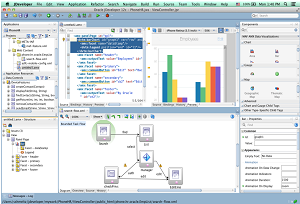News
New Oracle Framework Targets Cross-Platform Mobile Developers
- By David Ramel
- July 1, 2014
Oracle Corp. yesterday unveiled a new Mobile Application Framework (MAF) to simplify cross-platform app development for smartphones and tablets.
The offering is one of several new updates to the company's Oracle Mobile Suite, a development and deployment platform.
The MAF is the latest addition to an increasingly crowded collection of cross-platform mobile development tools based on the hybrid model. That approach seeks to strike a balance between OS-dependent native development and cross-platform Web-based development.
Native development requires different projects for each targeted platform and can be time-consuming and expensive.
Web-based apps can run on multiple platforms with one code base, but can't take advantage of certain native device capabilities such as cameras and accelerometers, don't offer the same look and feel of native apps, and often lack native app performance.
 [Click on image for larger view.]
Coding with Oracle MAF in JDeveloper
[Click on image for larger view.]
Coding with Oracle MAF in JDeveloper
(source: Oracle Corp.)
Hybrid models, through various techniques, try to strike a balance between the two approaches.
In Oracle's case, developers can use Java, JavaScript and HTML5 to build apps that include a lightweight Java virtual machine (JVM) serving as a native library for each targeted platform. The JVM executes the logic and data access and passes data to the HTML5 view to render the UI.
"Based on a hybrid architecture, Oracle MAF lets you build applications that are portable across devices and OSes while still leveraging the device-specific capabilities and delivering a rich UX," according to the company. "Applications developed with Oracle MAF can be designed for phone and/or tablet form factors and packaged for either Apple iOS or Google Android -- from a single code base."
The new tool also supports Apache Cordova plug-ins, another technology that lets developers leverage specific device features across different OSes. "Oracle MAF is going to enable our consultants to accelerate the delivery of mobile implementations for our customers," Oracle quoted Luc Bors, principal analyst at AMIS, as saying. "The added support for extensibility through Cordova plug-ins and custom HTML5 UI components will further extend the scenarios where Oracle MAF can be used. We are also excited to see the possibility to leverage social security providers with the extended options for security implementation in Oracle MAF."
The new framework uses a Model-View-Controller (MVC) design approach and features declarative UI definition, integration of device services and built-in security.
It installs on a device and can be used in connected or disconnected scenarios, with access to device services and a local SQLite database. It can be used in the company's own JDeveloper or the open source Eclipse IDEs.
Oracle also announced updates for another Oracle Mobile Suite component, the Oracle Service Bus, which is designed to ease mobile enablement by exposing cloud-based or on-premises back-end applications via JSON and REST APIs.
Just a few days ago, Google Inc. announced similar new features to help Android developers connect their mobile apps to a cloud-based back-end platform.
For security, Oracle MAF integrates with the Oracle Mobile Security Suite, designed to protect corporate data and apps on devices and to securely deploy and manage any mobile application.
In the exploding arena of cross-platform mobile development tools, Oracle MEF joins other recent initiatives reported here, such as: Appmethod from Embarcadero Technologies Inc.; Xamarian; the PhoneGap Developer App from Adobe Systems Inc.; AppGyver; and products from Altova, Kony Inc., Verivo Software Inc. and Digia.
And Oracle itself in May announced Application Development Framework (ADF) Mobile for Java Enterprise Edition. Oracle yesterday said its MAF includes support for applications developed under Oracle ADF Mobile.
According to analyst Laura DiDio, the new products from Oracle and other vendors in the mobile market are to be expected, almost a means of self-preservation. "Mobility is one of the hottest market arenas," said the principal analyst at Information Technology Intelligence Consulting Corp. "There isn't a single vendor that I can think of that isn't expanding its product portfolio or inking partnership deals to support mobile applications.
"Mobile applications are a natural extension of desktop and server-based applications. Since Oracle is a top tier vendor with a large installed base and a large, established reseller network, this move was to be expected; it's a natural evolution. The only surprise would have been if Oracle didn't come out with its own MAF network. This is the type of move that every vendor including Oracle must make in order to stay current with technology trends and remain competitive."
DiDio said the new product should indeed be competitive in the market. Dual iOS/Android targeting "is very appealing to developers and prospective end users alike since the iOS and Android platforms account for over 90 percent of mobile devices," she said. "The ability to build/extend enterprise applications for both iOS and Android from a single code base will cut down on coding errors and allow developers to speed the time it takes to get new mobile applications to market."
About the Author
David Ramel is an editor and writer at Converge 360.